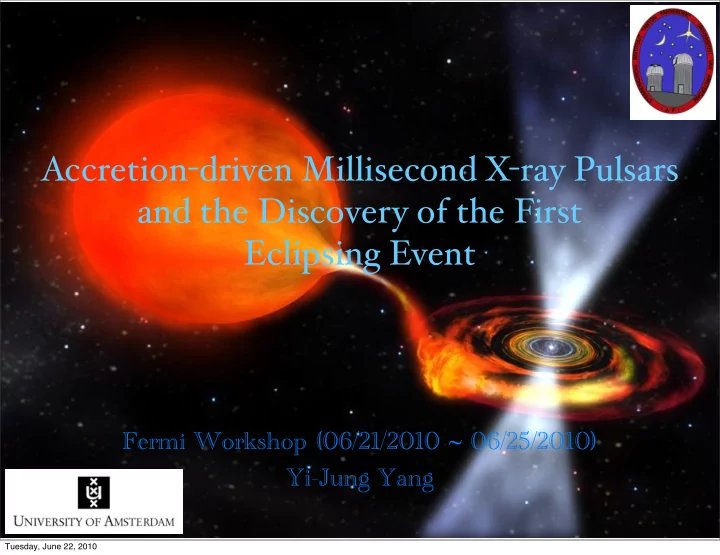

Accretion - driven Millisecond X - ray Pulsars and the Discovery of the First Eclipsing Event Fermi Workshop (06/21/2010 ~ 06/25/2010) Yi-Jung Yang Tuesday, June 22, 2010
Outline • Classification of Pulsars • Accretion-driven Millisecond X-ray Pulsars (AMXPs) • Discovery of the first eclipsing Event • Summary Tuesday, June 22, 2010
Pulsar Basic Rotation - powered Pulsars Radio Millisecond Pulsars Rotational Radio T ransients Optical Pulsars Isolated X - ray ( i.e. Magnificent 7 ) Gamma ray ( i.e. Geminga, Lupin Lin’s talk ) Anomalous X - ray Pulsars ( AXPs ) Magnetar Pulsars Soft Gamma - ray Repeaters ( SGRs ) LMXB ( i.e. AMXPs ) Accretion - powered ( Radio Quiet ) HMXB Binary Millisecond Pulsars Radio Loud Double Pulsars/Pulsar + NS Pulsar + Main sequence star Tuesday, June 22, 2010
P - P ( dot ) Diagram Tuesday, June 22, 2010
Accretion - driven Millisecond X - ray Pulsars According to the recycling scenario, millisecond radio pulsars are produced by spin up via the transfer of angular momentum through accretion. During the phase ( ~10 Gyrs ) , they would be expected to emit X - ray pulsations. Therefore one would expect some accreting neutron stars to be observed as accretion powered X - ray pulsars in the process of spinning up in the millisecond range. Tuesday, June 22, 2010
Periodic variability of AMXPs The blackbody emission from the hot spot where the magnetic funnel flow impacts the neutron star surface, transforming the kinetic energy into radiation. Since the funnel flow is relativistic, a shock is expected to appear. The thermal radiation emitted by the hot spot can the be Comptonized by the shock and upscattered to higher energies ( Poutanen & Gierlinski 2003 ) Tuesday, June 22, 2010
Other properties of AMXPs Quasi - periodic Oscillations ( QPOs ) : Apart from the coherent millisecond variability, AMXPs show quasi - periodic variability on timescales of milliseconds up to hundred seconds ( Linares et al. 2005, 2007, 2008 ) However, the origin of this phenomenon is not yet clear. Thermonuclear ( runaways ) X - ray Bursts: usually called Type I X - ray Bursts Burst Oscillations: which are observed with a frequency close to neutron star spin. Only three AMXPs found with burst oscillations so far. ( SAX J1808.4 - 3658, XTE J1814 - 338 and Aql X - 1 ) Tuesday, June 22, 2010
List of AMXPs found up to date The first accreting millisecond X - ray Pulsar was discovered in 1998 ( SAX J1808.4 - 3658, Wijnands & van der Klis 1998 ) Note: All AMXPs are LMXBs. Frequencies are ranging from ~ 180~600 Hz. Tuesday, June 22, 2010
Discovery of the First Eclipsing AMXP Swift J1749.4 - 2807 • First discovered by Swift/BAT as GRB060602B • Later was realized it is an accreting neutron star binary system instead of GRB (Wijnands et al. 2009) • Outburst in April 2010 detected by Integral with RXTE, Swift/XRT and Chandra follow-ups • Eclipses found in RXTE and Swift observations Tuesday, June 22, 2010
The Swift/BAT lightcurve of GRB060602B in di ff erent energy range. ( Wijnands et al. 2009 ) Tuesday, June 22, 2010
Tuesday, June 22, 2010
Type I Burst by Integral ( Ferrigno et al. 2010, ATel#2648 ) Tuesday, June 22, 2010
Eclipses found by RXTE ( Altamirano et al. 2010 ) Tuesday, June 22, 2010
Pulse Profiles of Swift J1749.4 - 2807 ( Ferrigno et al. ) Tuesday, June 22, 2010
Folded Lightcurves RXTE Swift/XRT Tuesday, June 22, 2010
( Altamirano et al. 2010 ) Tuesday, June 22, 2010
At inclinations close to 90 degree the central source is not visible, only scattered X - rays from a wind or accretion disc corona can be seen ( partially eclipsed by the companion star ) . Between inclinations of about 60~80 degree the central source is visible, but with dips. Below 60 degree the central source is always visible. Tuesday, June 22, 2010
Tuesday, June 22, 2010
Tuesday, June 22, 2010
Summary • There are so far 13 AMXPs found. They might be the link between radio pulsars and radio MSPs. • The first eclipsing event was found by RXTE and Swift, which helped to constraint the inclination angle, as well as other parameters. • Further observations and studies are needed to confirm the role of AMXPs in recycling scenario. Tuesday, June 22, 2010
Recommend
More recommend